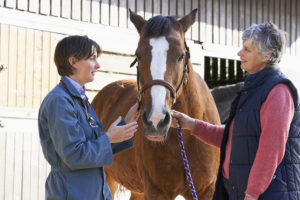A Look at the Alternative
This year marks the 250th anniversary of veterinary medicine, as the world’s first veterinary school opened in Lyon, France in 1764. However, veterinary medicine has been around since people and animals have coexisted, and there are many ancient techniques in veterinary medicine that have been used for thousands of years. Those ancient techniques are reaching the forefront once more as clients demand all available treatment options for their pets and veterinarians start to consider the staying powers of antique methods.

According to Dr. M.A. Crist, clinical assistant professor at the Texas A&M College of Veterinary Medicine & Biomedical Sciences (CVM), alternative veterinary medicine is best described as a term for a group of treatments or modalities that lie outside of the conventional or mainstream treatment of veterinary medicine. Occasionally, the terms “alternative veterinary medicine”, “integrative veterinary medicine”, and “complementary veterinary medicine” have been used as synonyms; therefore, veterinarians now use the acronym CAM to reference all three terms.
The American Veterinary Medical Association guidelines for alternative and complementary medicine state that holistic veterinary medicine includes, but is not limited to, the practice of acupuncture and acutherapy (involves the stimulation of specific points on the body by use of acupuncture needles, low level lasers, and other tools), botanical medicine (the use of plants and plant derivatives for treatment), chiropractic (refers to the adjustment and alignment of specific joints to create comfort), homeopathy (unique form of medicine), massage therapy (touch technique used to eliminate pain and to improve the blood-flow) , nutraceuticals (the use of nutritional supplements to aid in treatment), as well as conventional medicine, surgery and dentistry.
“Holistic veterinary medicine considers all aspects of the animal’s life in the context of its environment, behavior, medical and dietary history, emotional stresses as well as a comprehensive physical examination, and other factors that may play a role in the animal patient’s life,” explains Crist. “In other words, diagnosing and treating the animal patient in the context of the ‘whole’ patient.”
Most alternative medicine treatments are based on clinically accepted medicine. However, it is difficult to find scientific data to support the theory that these modalities are safe and effective. More clinical data is becoming available, but it is a very slow process due to limited funding for research.
There are still a lot of questions concerning alternative veterinary medicine techniques as some practitioners believe there is still little evidence today to back up the powerful claims.
“Some veterinary practitioners view complementary and alternative medicine as controversial,” notes Crist. “Some critics believe that there is limited to no evidence-based data to support unconventional therapies or modalities and others claim that the evidence-based data to support these therapies is of poor quality.”
“Owners need to understand that some of these modalities are slow and gentle and take time to take effect,” says Crist. “Others may believe that alternative medicine does not work at all, because they may have waited too long in the disease process and despite what therapy is used, nothing will work.”
“The approach in the field of complementary and alternative veterinary medicine is the philosophy that an integrated approach with conventional veterinary medicine will increase the chances that the patient will do well,” explains Crist. “Conventional and alternative veterinary medicine is becoming more available from veterinarians because of client demand and also because some veterinarians are recognizing the value in using these alternative modalities in their patients.”
If an animal does partake in any alternative technique without the care of its primary veterinarian, it is necessary for the owner to notify its primary veterinarian of any alternative modalities; especially if a pet takes medications, herbs, and supplements on a regular basis. Some of these therapies may interfere with other medications prescribed by the veterinarian.
“The FDA has classified herbal products as food supplements and they are marketed as such,” says Crist. “Most herbal products or remedies are sold in various forms such as dried bulk, herbs, oils, tinctures, ointments, creams, and capsules. It is important to purchase high-quality products from a reputable and established supplier.”
If interested in learning more about alternative veterinary medicine practices, it is important to visit with a veterinarian who is trained in CAM. To practice in any of these modalities veterinarians must first be certified and well versed in their area of interest within the scope of complementary and alternative medicine.
“These modalities should be practiced by a veterinarian with licensure and referral requirements concerning each modality,” explains Crist. “The certification includes hundreds of hours of continuing education in that field, numerous examinations, multiple case reports, and hours and hours of shadowing an expert in the field. It is important that if an owner requests any of these integrated modalities that he or she is referred to a veterinarian certified in that field. It is also important that if they are referred by their regular veterinarian, that the two work together to do the best for the pet.”
Alternative veterinary medicine is another option for the treatment of your pet. It is your job to do extensive research and consult with your veterinarian to decide if it is the best option for your pet.
Pet Talk is a service of the College of Veterinary Medicine & Biomedical Sciences, Texas A&M University. Stories can be viewed on the Web at vetmed.tamu.edu/news/pet-talk. Suggestions for future topics may be directed to editor@cvm.tamu.edu.


